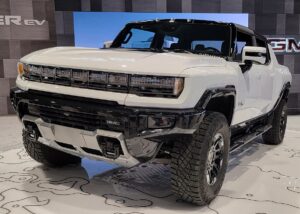COLUMBUS, Ohio – The Army has approved its prototype requirement for the Electric Light Reconnaissance Vehicle (eLRV) effort, with an official confirming the fiscal year 2024 budget request includes funds for “working the early stages of the program.”
Tim Goddette, deputy assistant secretary of the Army for sustainment, on Tuesday detailed the ongoing vehicle electrification initiative while noting it’s “probably unlikely” the service will have electric vehicles (EV) in its tactical fleet until 2050.

“There’s really an expectation that we won’t even get all non-tactical vehicles on our installations to an EV or near-all EV status until 2035. And the same thing on the tactical wheeled vehicle side, it’s probably unlikely that we’re going to have EVs until 2050. And that’s not just because the technology’s not ready. We’ve also got the reality of how long does it take to turn a fleet over. If you just bought a vehicle, you’re not going to replace a four-year-old vehicle,” Goddette told attendees at NDIA’s Tactical Wheeled Vehicles conference here.
Goddette told reporters following his remarks that hybrid-electrification for its tactical wheeled vehicle fleet, which includes about 100,000 light, 60,000 medium and 45,000 heavy vehicles, is likely “around the corner” depending on the results of ongoing research and prototyping efforts.
“That one’s much more likely to make it into the field in the nearer term, think over the next five or six years, depending on what comes out of the Humvee, JLTV and FMTV world,” Goddette said. “When you look at the quantity and the amount that we buy in a year, I think what you’ll find is you may be on a hybrid-electric path but when the technology’s ready we won’t, just because we haven’t finished hybrid, wait. It’ll be a timing issue because that fleet’s constantly turning over.”
The Army has previously described eLRV as the “first and most promising of developmental opportunities being pursued under the tactical and combat vehicle electrification initiative seeking to tackle hybrid or purely electric capabilities for many more combat platforms” (Defense Daily, June 2 2021).
Last July, the Army awarded deals to GM Defense [GM] and advanced mobility startup Canoo [GOEV] to each provide an electric vehicle for demonstration, with the goal of informing the eLRV program (Defense Daily, July 26).
The Army is planning for FY ‘24 funding to yield eLRV prototype deliveries in FY ‘25, according to slides Goddette presented.
Along with moving ahead on eLRV, the Army is also planning to assess prototypes for a JLTV outfitted with anti-idle technology and Transmission Integrated Generators designed to provide increased onboard and exportable power in 2023, according to the slides.
Goddette said the Army remains “followers” to commercial industry when it comes to exploring vehicle electrification opportunities.
“We wait for the investments. We wait for the price margins to come down. And we wait for the technology to be proven out. So I would argue we’re probably fast followers, or we should be fast followers. We should be looking at the technologies and looking at the opportunities where we can bring it in not just because the technology’s ready but because it’s affordable, because it’s reliable and because we’re taking advantage of the great industrial base that we have in the commercial marketplace that is very closely aligned with what we do with tactical wheeled vehicles,” Goddette said.
As the Army pursues hybrid-electric and full electrification for its tactical wheeled vehicle fleet, Goddette said the service must still answer key “concept of operations” questions, such as where batteries will be stored on vehicles and how to establish the necessary recharging infrastructure.
“It’s not just about technology. It’s not just about writing requirements. It’s about the [concept of operations] on how you’re going to use that technology and does that technology work in the application that you intend it to work in,” Goddette said. “If your batteries are so heavy that you have a five-ton truck that has four-and-a-half tons of batteries on it, it doesn’t leave a lot of room for cargo. Okay, so you have to get the things in balance.”